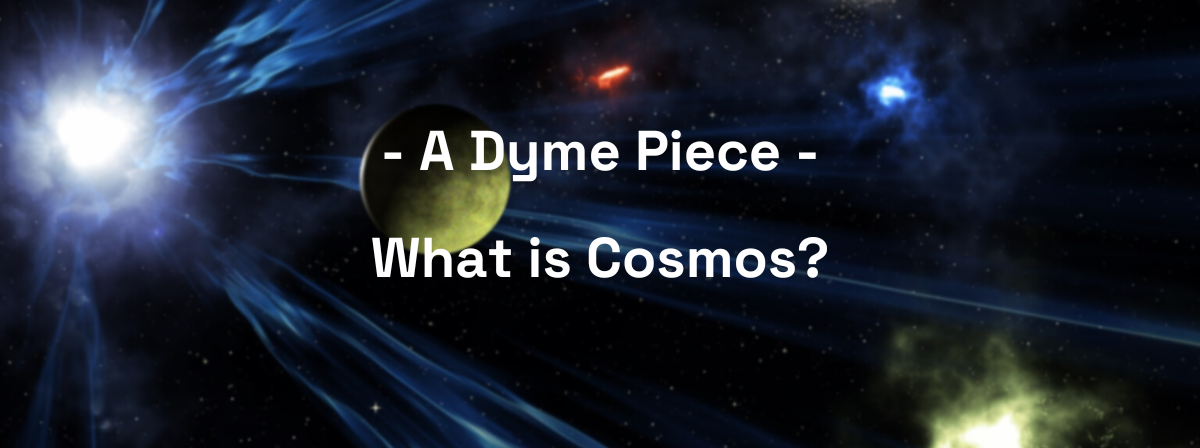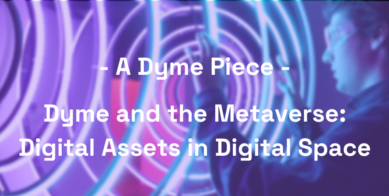Cosmos is not a blockchain. Cosmos is not a cryptocurrency. Cosmos is a “novel blockchain network architecture,” according to its 2016 whitepaper.
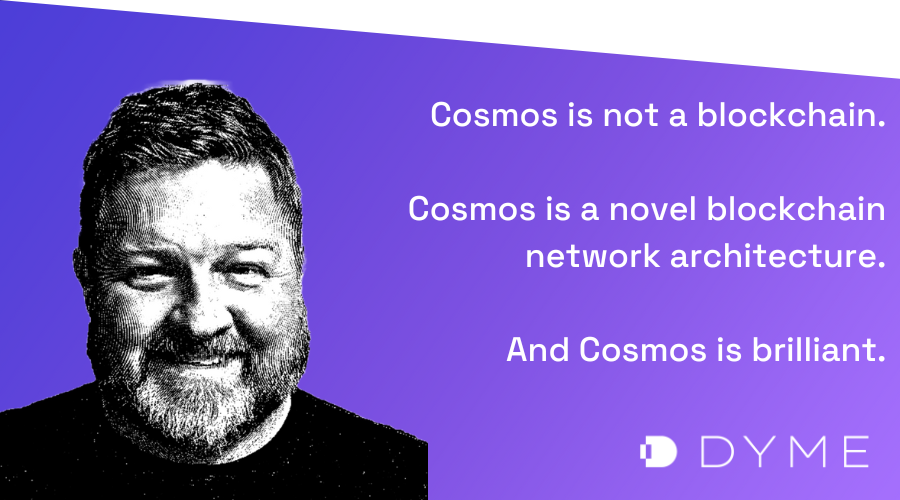
Cosmos does have a native crypto, ATOM. As Dyme is part of the Cosmos network of blockchains, this Dyme Piece addresses a simple question: What is Cosmos?
As we answer that question, we will also examine why Cosmos is such a good choice for Dyme and how we see Dyme and Dyme’s native cryptocurrency, DYME, interacting with the Cosmos community of blockchains.
Why does blockchain need a network architecture like Cosmos?
At a very simple level, an interoperable network architecture is needed so that blockchains can communicate with one another. The siloed nature of most blockchain networks limits both adoption by consumers and innovation by creators. And since most blockchains have a fintech core, this slows crypto adoption.
Why don’t blockchains talk to one another?
Most blockchains don’t talk with one another. Interoperability has always been a challenge for blockchain. The first major blockchain innovation was Bitcoin; the second major innovation was blockchain. Essentially, once Bitcoin showed how blockchain could work, the community decoupled blockchain from Bitcoin.
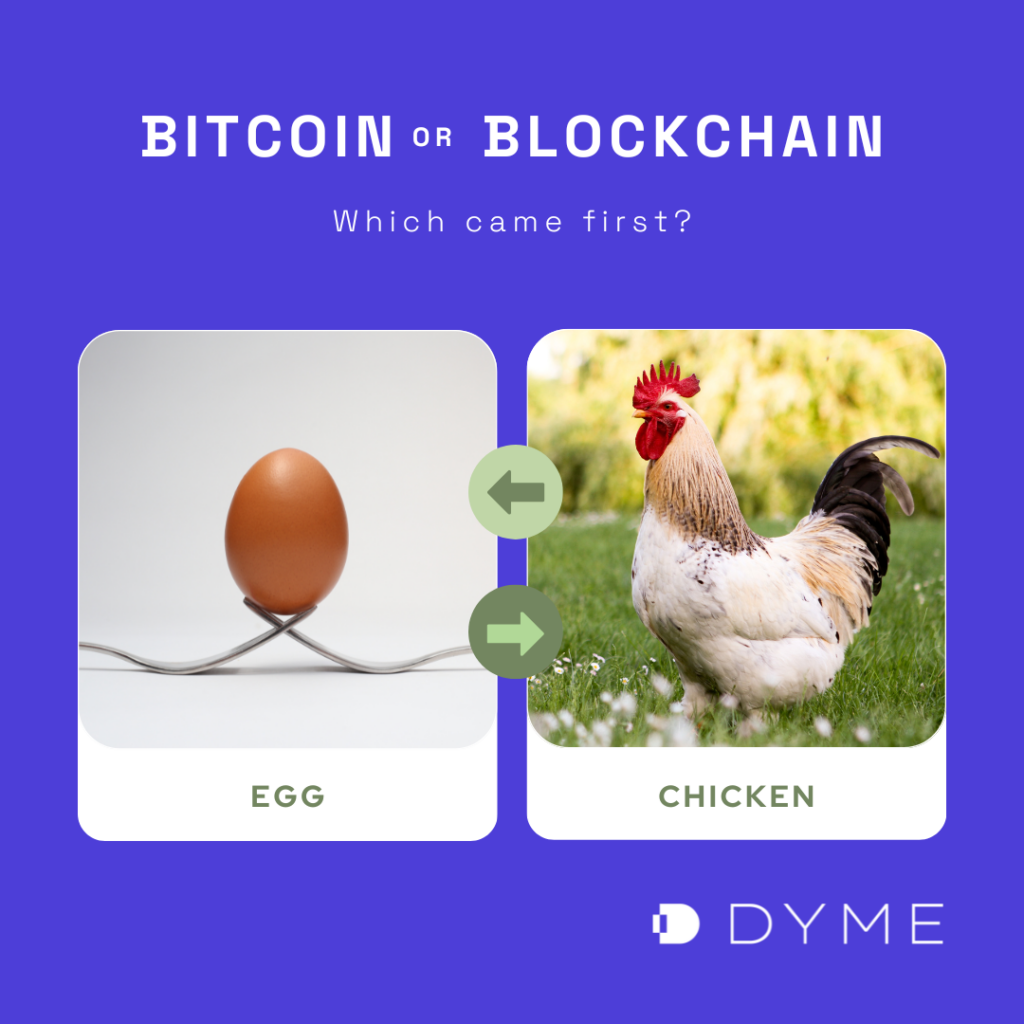
While this sounds a bit like a joke about a chicken and an egg, the resulting trustless inter-organizational cooperation mechanism of blockchain gave rise to some terrific growth. But much like the early days of the Internet, interoperability was not a core construct in the blockchain.
Interoperability is what enables communication between two or more systems. Email interoperability is what lets your Gmail account exchange email with your Office 365 account. Short messaging service (SMS) interoperability is what lets your iPhone text message be received by an Android phone. And Internet interoperability is what lets computers talk to one another across various networks.
The Internet interoperability problem was largely solved in 1981 with the release of RFC 791, titled “Internet Protocol.” The Internet Protocol’s routing function enables internetworking and essentially establishes the Internet. RFC 791 was built on work started in 1974 by Bob Kahn and Vint Cerf.
Summing up interoperability: it takes time and experimentation to get interoperability right, but once you do, it’s a rocket ship ride!
A brief history of Cosmos
College graduate student Jae Kwon first wrote about Tendermint in 2014 as an energy-efficient alternative to Bitcoin. Kwon reasoned that a novel consensus protocol could avoid the high cost, high energy use, and long confirmation times endemic to Bitcoin’s proof-of-work-based consensus protocol. Where Bitcoin solved the problem of trustless currency exchange and spawned the crypto industry, Tendermint solved problems Bitcoin raised in crypto mining.
Two years later, Kwon and Ethan Buchman used Kwon’s writing about Tendermint (which they called Tendermint BFT in their white paper) as the foundation for Cosmos. Where Tendermint in 2014 solved inefficiencies in mining, Cosmos in 2016 addressed problems in blockchain interoperability.
The Swiss-based Interchain Foundation (ICF) was established in 2017 to shepherd the Cosmos ecosystem. That year, the Foundation ran a two-week initial coin offering (ICO) of the ATOM cryptocurrency, accumulating over $17 million.
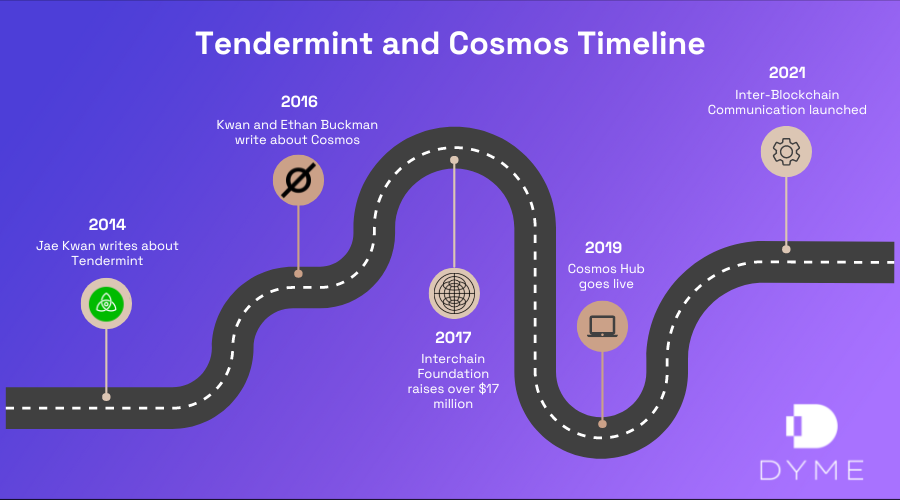
On the corporate side, Tendermint, Inc. raised a $9 million Series A venture investment in 2019. Cosmos Hub launched in what Cosmos enthusiasts call “the big bang” on March 13, 2019.
Cosmos graduated from a white paper to software in 2019 with a software development kit (SDK) for blockchain developers and with the launch of the first Tendermint blockchains. The Inter-Blockchain Communication (IBC) protocol was launched in 2021.
On March 1, 2022, Tendermint transitioned “Cosmos marketing and community initiatives and channels” to the ICF. This added to confusion about the long-term prospects of Cosmos, which were further impacted by the collapse of the Cosmos project Terra. However, with over $70 billion in digital assets under management, Cosmos remains a powerful player in the Layer One blockchain space.
Today, what was Tendermint (or Tendermint BFT or Tendermint Core at various times) is now Ignite CLI. It is the corporate entity (or corporate successor) to Tendermint, Inc. The Interchain Foundation continues its mission of being “stewards of the interchain internet.” Perhaps most importantly, the need for an interoperable blockchain network architecture remains very high.
What does a blockchain network architecture do?
A blockchain network architecture is the Internet Protocol for blockchains. Cosmos is a means for blockchains to interoperate in the same way that IP is a way for data networks to internetwork. Why didn’t the authors coin the term “interblockchain?” The world may never know.
The Cosmos authors understood this comparison between blockchain and the Internet, writing that independent blockchains “of the Cosmos network communicate with each other via an inter-blockchain communication (IBC) protocol, a kind of virtual UDP or TCP for blockchains.”
The Cosmos network architecture draws resiliency from this structure. The IBC protocol allows participants to freely exchange assets, services, and data across sovereign, decentralized blockchains.
How does Dyme use Cosmos and the IBC protocol?
Without shifting the conversation too much, Dyme has built an economic structure supporting the diverse needs of Web3 and metaverse projects. As blockchain is fundamentally a means for non-sovereign currency and trustless settlement between parties, Dyme identified a need for not just a blockchain but also the economic structures to support a financial infrastructure across Web3 and the metaverse.
Cosmos is an optimal environment for Dyme’s work. Using the same hub and zone structure as Cosmos, Dyme serves as the economic hub and the various Dyme projects serve as zones. Dyme can allow interoperability between different economies without forcing a particular governance or economic regime on the projects.
Dyme’s first project is Lifetoken. Lifetoken is a Web3 social network that adds the means to reward participation on a social platform. The resulting audience activation has exciting potential to both provide a democratized way for brands and creators to pay for meaningful results and an egalitarian way for audiences to participate in the economic benefit of using the platform.
The Lifetoken team built Dyme, and in mid-2022, realized the broader need for Dyme as a reserve cryptocurrency for Web3 and the metaverse.
How does Cosmos work?
Cosmos is an ever-expanding network of apps, data, and services interconnected with one another. Cosmos connects blockchains using what they call the Cosmos Hub and by promoting the use of the Cosmos SDK (software development kit) and Ignite blockchain.
Described differently, Cosmos uses its native ATOM cryptocurrency, the Ignite consensus algorithm, hubs, and the Inter-Blockchain Communication (IBC) Protocol to permit blockchains to communicate securely.
The blockchain: Ignite CLI (or what used to be called Tendermint BFT)
At the core of Cosmos is Ignite. In the Cosmos community, Ignite is called a Tendermint Byzantine fault tolerance (BFT) engine consensus protocol. It’s a blockchain. It’s more correctly called a Layer One blockchain since it is a foundational blockchain on which blocks are produced, transactions are finalized, and a native cryptocurrency coin is used to pay transaction fees and reward those who secure the network.
The difference is Ignite allows developers to build their projects using a blockchain without building the blockchain from scratch. It does require developers to establish and nurture a group of validators, so it’s not an entirely hands-off project. And project developers do need to host an instance of Ignite on their own.
Notionally, Cosmos will work with any BFT engine consensus protocol. This gives some context for why the Interchain Foundation bears that name: it should be able to work with a second, albeit compliant, blockchain.
The Tendermint BFT algorithm validates transactions and executes blocks to the blockchain. It uses a protocol called the application blockchain interface to connect to applications. The protocol functions through a proof-of-stake (PoS) validation and governance mechanism.
The Cosmos Hub is the central hub of the Cosmos ecosystem.
The Cosmos Hub
Remembering that a “Cosmos zone” means an “Ignite blockchain”, each zone connects to another zone through hubs. Cosmos Hub is the main one, but other hubs are also available.
Each zone is expected to function autonomously. This means the zone will authenticate accounts and transactions, will create and distribute new tokens, and will execute blockchain changes. Any zone or hub does not necessarily have to work with another, but each new zone is linked to the Cosmos Hub. The Cosmos Hub records each zone’s state. In this way, the Cosmos Hub behaves a bit like a DNS root server – it provides canonical information about every blockchain in the Cosmos universe.
Cosmos Hub facilitates interoperability between all Cosmos zones within the network by keeping track of their states. The Cosmos Hub also allows interoperability with proof-of-work (PoW) blockchains like Bitcoin and Ethereum through bridges. The best-known Cosmos bridge is Gravity Bridge, developed by Blockscape. Gravity Bridge connects Cosmos and Ethereum blockchains and Blockscape is incredibly well-regarded in the Cosmos community.
Aside from bridges, Cosmos hubs and zones communicate through the Inter-Blockchain Communication protocol, which serves as the base for “the Internet of Blockchains.”
Inter-Blockchain Communication (IBC) Protocol
The IBC Protocol serves two complementary purposes. First, it powers the Cosmos Hub by allowing the transmission of secure messages between disparate blockchains. This process enables project teams to build a sovereign, decentralized blockchain with their own governance and rules and lets users freely and securely exchange assets and data across those blockchains.
Second, the IBC Protocol allows other Cosmos projects to behave like the Cosmos Hub. This lets Cosmos projects build projects beneficial to a subset of the Cosmos ecosystem or to the entire Cosmos ecosystem without requiring either path.
The Cosmos Hub is aptly named. By serving as the hub (which was previously compared to a DNS root server) of the Cosmos “Internet of Blockchains,” Cosmos Hub is essentially a service provider. And much like a DNS root server, the Cosmos Hub both delivers information and serves as a clearing house for disparate networks.
Cosmos blockchains are not limited to fintech projects. They can do practically anything, from crypto issuance to nonfungible token (NFT) transfers to social networks to consumer marketplaces..
So Cosmos hosting is a thing?
Well, sort of. Project developers do have to host an instance of their blockchain. This is an unusual step if you’re used to developing on most other blockchains.
The benefit is that your project owns your instance of the blockchain and is not dependent on someone else’s chain to operate. As different chains and different coins have shown, depending on a blockchain you don’t control is sometimes a dangerous proposition.
What problems does Cosmos solve?
Cosmos fixes three major problems with blockchains: scalability, usability, and interoperability.
Scalability: Growth without crippling the power grid
If Mel Brooks taught us anything, it’s that “it’s good to be the king.” The Cosmos SDK allows project developers to build sovereign blockchain apps without substantial time commitment in building a unique Layer One protocol and without expensive ongoing costs.
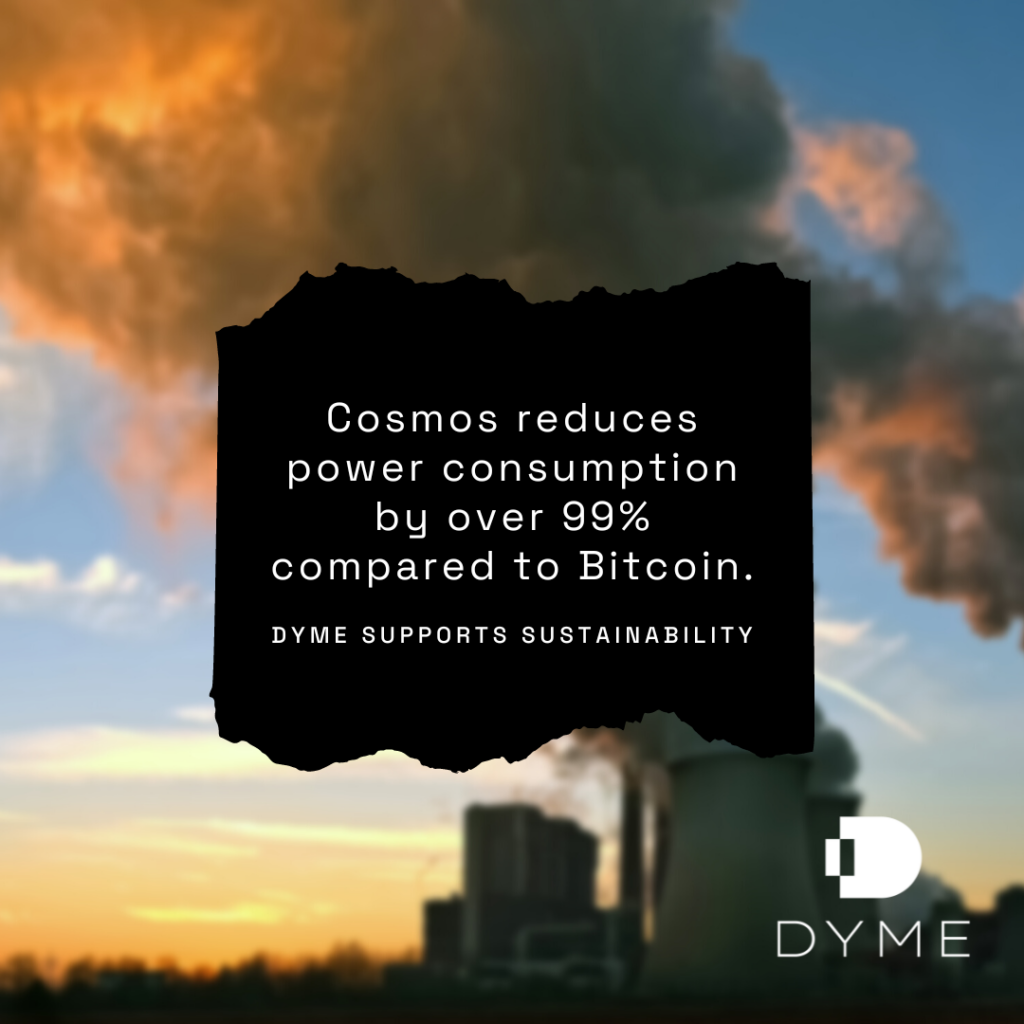
These blockchains can easily interconnect without relying on smart contracts to exist on a different blockchain. This avoids both high transaction fees and mitigates an attack vector exploited by dozens of major crypto attacks. It also avoids network congestion of the big smart contract chains like Ethereum while developing better scaling features.
It’s also worth mentioning that the Ignite blockchain has a 99% smaller carbon footprint than an equivalently sized Bitcoin blockchain.
Usability: Built for developers
The scalability benefits of Cosmos come with usability benefits, as well. The Cosmos SDK continues to mature through the support of an active developer community, and new exemplar projects are regularly started, which give rise to new ideas and new opportunities for ecosystem integration.
This will boost innovative in areas as diverse as decentralized finance (DeFi), NFTs, gaming, decentralized autonomous organizations (DAOs), social networks, and consumer marketplaces. Fundamentally, developers can use Cosmos when the project economy relies on the internet. This is particularly true in the ownership economy where everyone has a stake.
Interoperability: Knocking down silos, embracing the Internet model
Cosmos interoperability is what guarantees the functioning of a scalable system. By integrating to Cosmos interoperability model of shared communication standards, any sovereign blockchain can communicate with another. This provides a larger ecosystem for business growth and a technical environment that contributes to advanced protocol design.
Cosmos interoperability scalability is obtained by splitting a dApp into multiple application-specific blockchains, or by optimizing the structure of a particular blockchain architecture. Interchain token transfers allow these multiple Cosmos chains to continue in one cohesive ecosystem.
Why does Dyme use Cosmos?
Cosmos is an optimal environment for Dyme’s work. Using the same hub and zone structure as Cosmos, Dyme serves as the economic hub and the various Dyme projects become zones that benefit from the economic behavior of Dyme’s eponymous native cryptocurrency. Dyme can thus allow interoperability between different economies without forcing a particular governance or economic regime on the projects.
Dyme believes it has built an economic structure that supports the diverse needs of Web3 and metaverse projects. As blockchain is fundamentally a means for non-sovereign currency and trustless settlement between parties, Dyme identified a need for not just a blockchain but also the economic structures to support a financial infrastructure across Web3 and the metaverse.
Dyme’s first project is Lifetoken. Lifetoken is a Web3 social network that adds the means to reward participation on a social platform. The resulting audience activation has exciting potential to both provide a democratized way for brands and creators to pay for meaningful results and an egalitarian way for audiences to participate in the economic benefit of using the platform.
The Lifetoken team built Dyme, and in mid-2022, realized the broader need for Dyme as a reserve cryptocurrency for Web3 and the metaverse.
Comparisons with other blockchains and Cosmos
Ethereum vs Cosmos
As Ethereum recently made good on a years-long effort to switch to PoS, the platform still suffers from scalability challenges. It may take minutes to even hours to execute an Ethereum transaction, and when the network gets congested, the cost of executing a smart contract grows.
Instead of the high gas cost and risk of slow settlement, Cosmos and Ignite handle just the project’s transactions. Similar to “not your keys, not your crypto” is the phrase “not your blockchain, not your schedule.” Ethereum operates on Ethereum’s schedule.
Make no mistake: Ethereum is not going to collapse. Ethereum is blessed with extreme popularity as a blockchain. Its network effect still makes it the favorite platform for DeFi, NFTs, and the metaverse. And Ethereum has an active Foundation working on its behalf and a robust developer community.
There is also a contrast between the on-chain smart contract structure of Ethereum and the “in-chain” module structure of Ignite. Ethereum is perhaps the most mature blockchain extant, and without diving too deeply into Ethereum sidechains and ETH-centric Layer Two alternative chains, every smart contract on Ethereum runs on the same chain.
This makes Ethereum a challenging platform to scale a project since the project immediately bears gas costs from its smart contracts. It also puts the economy of the project outside the control of the project.
Cosmos and Ethereum are similar in one way: the Ethereum Virtual Machine (EVM) structure allows for an alternative Ethereum chain to be built and for an EVM-compatible smart contract to run on it. This isn’t as robust as the IBC Protocol, but it’s an interesting comparison.
Closing
Hopefully, this helped explain what Cosmos is and how Cosmos works.
The choice of blockchain is a big one for a project and developers. Choosing poorly can mean either uncontrolled transaction expense, limited functionality, or sketchy availability. With Cosmos, Dyme has avoided all those problems.
And if you’re looking for a Web3 or metaverse currency, consider the Cosmos project Dyme!
